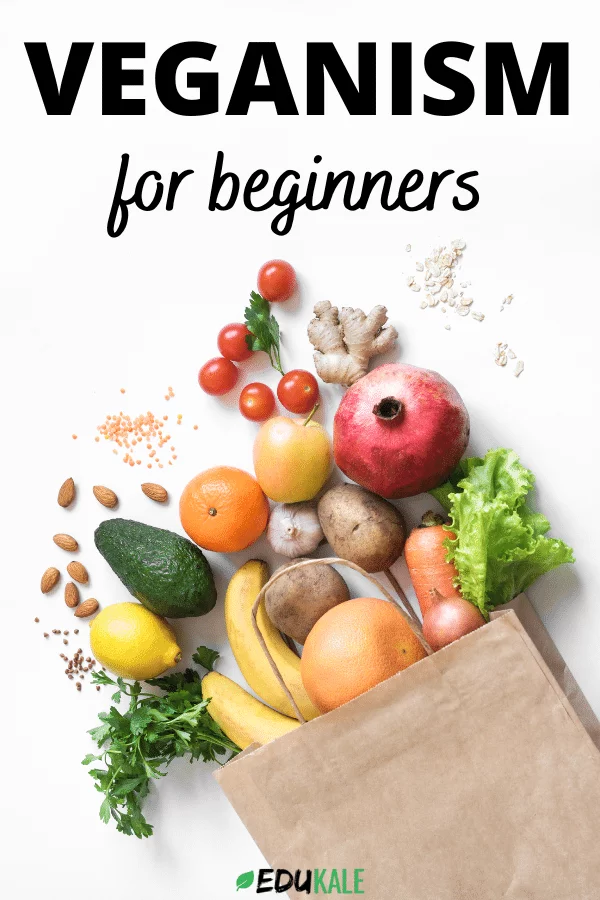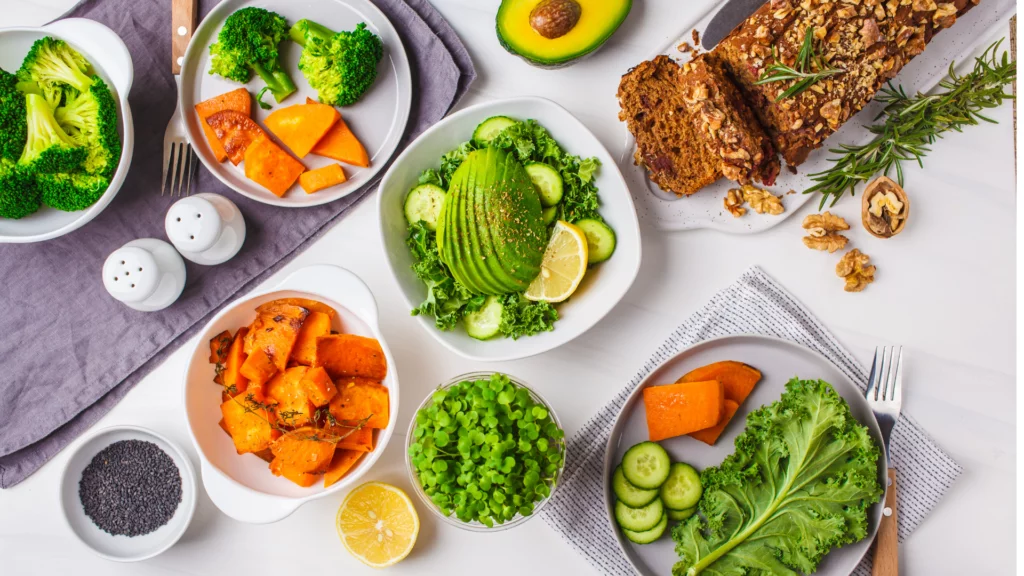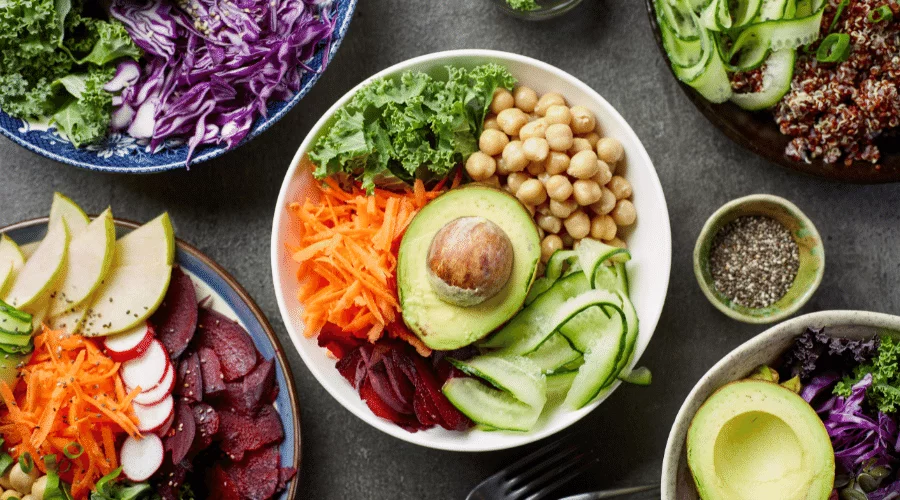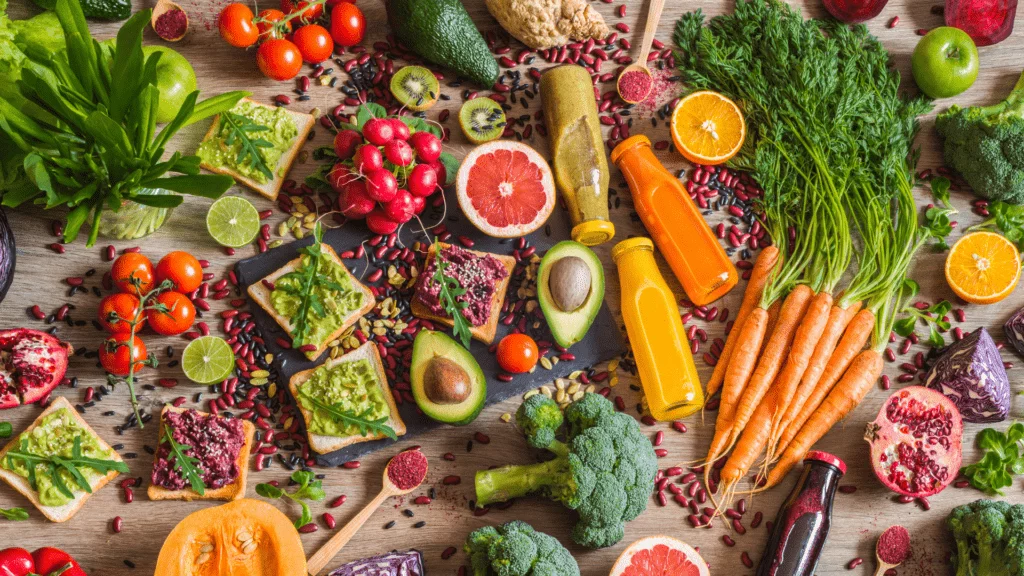Written by Lucie Villeneuve, nutritionist, M.Sc.
Even though you can absolutely be healthy on a diet that includes animal products, the scientific consensus shows that increasing your consumption of plant-based foods is what is best for your health [1,2]. So if you were wondering how to go vegan, here’s my complete beginner’s guide to veganism!

First of all, what does being vegan mean?
People who are plant-based don’t eat any animal products, so no meat (so red meat, poultry), fish and seafood, eggs, dairy, or honey. Vegans are plant-based but also exclude animal products from their lifestyles like clothing items containing silk, wool, leather, products that are tested on animals, going to zoos or circuses, etc.
For comprehension purposes and to simplify this article, I will be talking about being vegan while only focusing on the nutritional aspect.
How to become vegan
Which foods aren’t vegan?
First of all, aside from the obvious foods I just listed, here are a few foods that aren’t vegan: butter, mayonnaise, gelatin (in candy), whey, certain vitamins (like D3 made from lanolin, which comes from sheep wool), some white sugar (made with bone char), certain food dyes (red food dye made with carmine which comes from crushed beetles), certain potato chips, certain pasta made with eggs, certain crackers made with honey, certain sauces, certain alcohols…
If you want to be 100% vegan, you want to keep these foods in mind and always make sure to check the label.
Start slow, with small steps
With initial motivation, you may feel like doing everything at once, but this can quickly die down. So unless this is an ethical revolution for you, I highly recommend taking it step-by-step.
For instance, if you eat meat every day, try to reduce it to a few times a week. You can start by removing meat, then move on to removing dairy, or allow yourself to still have a few days with animal products, and little by little consume them less and less.
It’s also a good idea to incorporate fiber-rich foods in small portions at first to prevent boating. It will take your body some time to adjust!
Find some good vegan substitutions

Going vegan obviously means giving up certain foods, but thankfully there are a lot of great substitutions for them! I really recommend you get accustomed to them and use these substitutes in different recipes.
- Instead of meats, try meat replacements like beyond meat or impossible burger. You can also find mock chicken or mock fish.
- Instead of eggs, you have vegan eggs, just egg, or tofu scrambled eggs.
- Instead of dairy, there are a ton of plant-based milks and yogurts like oat, soy, coconut, almond… There’s also cashew cheese, vegan butter, etc.
- Instead of honey, you can try maple or agave syrup.
- You can also find things like vegan ice cream, vegan desserts, vegan bread and pasta, and more!
Hopefully this helps you see that being vegan doesn’t have to mean totally changing your meals. You can make the similar meals you usually make and just swap out the animal products for alternatives.
Even though a lot of people advise replacing meat with only whole foods, I actually find mock meats very helpful for an easy transition. I encourage looking for easy vegan cookbooks that specifically help you adapt your usual recipes to meat-free versions!
You can also look on Pinterest or Youtube for great recipe ideas.
I would advise you to work on mastering a few recipes at first, then moving on to new ones once you’re comfortable with them.
Get the vegan food essentials
As a vegan, make sure that your fridge is always full of fresh fruit and veggies, tofu, tempeh, plant-based milks, yogurts, and cheeses, vegan eggs, meat alternatives, vegan butter, etc

I also recommend always having a bunch of vegan non-perishable items in your pantry to make cooking easier. My favorite essentials include canned/jarred foods like black beans, kidney beans, white beans, chickpeas, corn, lentils, green peas, or green beans.
I also love dried fruit, nuts and seeds, and nut butter.
As for grains, I always have whole wheat pasta (make sure it’s vegan!), brown rice, bulgur, couscous, quinoa, and oats.
Don’t forget to stock up on frozen + canned fruits and veggies as well!
Make diverse plates
If you’re first starting out and don’t really know what you’re doing, becoming vegan can seem pretty bland or boring, but that’s really far from the truth! Make sure that you’re always creating really diverse plates. Not only will you get in a ton of nutrients and balance but also it will be much more fun, varied, and delicious. You can follow the plate method that I talk about in this article.
In short, make sure that half of your plate is veggies/fruit, that 1/4th is vegan protein, and that 1/4th is carbs. You can also make a bunch of different vegan bowls (one of my favorite meals!) You need to have plenty of ingredients on hand like avocados, tomatoes, different types of lettuce, red beans, black beans, corn, chickpeas, brown and white rice, lentils, bulgur, quinoa, sweet potatoes, pineapple, mango, blueberries, nuts…and mix and match them to make delicious vegan bowls!

Watch out for certain deficiencies
When done well, a vegan diet is beneficial for your health, but you do have to be a little bit more careful about avoiding certain deficiencies.
As a vegan, it’s absolutely crucial that you take a form of vitamin B12, that you can only find in animal products (because they are supplemented with it!) The daily value for vitamin B12 is 2.4 mcg for adults and children aged 4 years and older. For reference, that’s about the amount you would get in 3 ounces or 85 grams of salmon.
You can find B12 in fortified vegan foods like nutritional yeast, breakfast cereals, or plant-based milk & yogurt, but unless you’re checking the labels and making sure to have these foods every day, you should definitely get a supplement [3].
Also if you’re used to eating a lot of red meat or seafood, be mindful of your iron levels and make sure that you’re eating plenty of foods like spinach, beans and legumes, tofu, dark chocolate… Some foods are also iron-fortified (cereal, for instance), and make sure to eat your iron food sources with vitamin C to increase absorption. You can read my article on iron-rich foods if you want more information!
Finally, make sure that you are getting enough calcium and vitamin D from plant-based milks or cheeses (they have to be fortified so check the label!) If not, you can also take a vitamin D2 supplement, which is vegan, because vitamin D3 is not.
How to eat enough protein as a vegan

Your body can’t really store protein, so it’s important to get enough quality protein from your food every day. Meat is an important and easy source of protein, and while you can totally get enough protein on a vegan diet, it does take some more planning.
Yes, it’s true that most animal foods are complete proteins, meaning that they contain each essential amino acid in a sufficient amount. They are also a bit more digestible than plant proteins, as they contain fewer antinutrients.
However, a lot of plant foods have a great amino acid profile as well. They often contain all the essential amino acids, but may have a limiting one quantity-wise. All you need to do to counterbalance that is to multiply your protein sources. And you don’t need to be getting in all the amino acids at once, a few different sources throughout the day is good.
Some good sources of plant-based protein include tofu, oats, edamame, corn, chickpeas, lentils, beans, nuts, quinoa, whole-wheat pasta… The idea on a vegan diet is to include multiple sources of protein in one meal, so you can get in the complementary amino acids.
It can also be a good idea to include more processed (but still very useful) foods like vegan meat and dairy alternatives and vegan protein powder to your diet as well, at least until you get used to eating more whole plant-based protein!
Can anyone be vegan?
Not everyone will benefit from a vegan diet. Aside from the financial privilege aspect that I explain in my vegetarian for beginners article, there are other reasons why it may not be for you.
People with soy and nut allergies or people who are intolerant to legumes will find it hard to get enough protein on a vegan diet. People who have celiac disease or gluten intolerance may also find it hard to find a both vegan and gluten-free option. This may also be the case if you have IBS, need to eat a low fodmap diet, etc.
Some people have fructose malabsorption or intolerance, which can make it difficult to consume a lot of vegan foods. Also, people with eating disorders like anorexia or people trying to recover would benefit from being restriction-free, so not vegan. You don’t want to trigger any kind of restriction in the name of health.
Finally, if you have autism spectrum disorder or anything else that leads you to have few safe foods that you can eat, it wouldn’t be a good idea to reduce that already small spectrum.
Even if it is possible to be vegan with one of these issues, it’s definitely a question of balance and priorities. Make sure that you’re not imposing too much on yourself at once!

Bonus tips:
- Remember not to be too hard on yourself, it’s better to be 95% vegan and have some slip-ups rather than doing nothing because you’re too scared of messing up! Also, be kind to others. Don’t be preachy, and inspire them rather than criticize them.
- Remember to schedule in some extra time for all the new meal planning/grocery shopping/cooking at the beginning, so you won’t feel too frustrated!
- If you’re going vegan in a non-vegan household, explain why in a calm, rational way, without attacking anyone for their choices. If they show some interest, you can watch a documentary with them, give them some articles to read… You can also offer to help cook vegan recipes with the person who cooks in your household, show them recipes, show them the already vegan ingredients in your pantry…
- Make sure to keep the motivation going by making fun and tasty recipes, trying new foods all the time, following inspirational vegan cooks or creators, and remembering what got you started into veganism in the first place!
Hopefully you found this beginner’s guide to veganism helpful. Remember to start slow, stock up on vegan food essentials, make diverse plates, and watch out for certain deficiencies!
-Lucie

